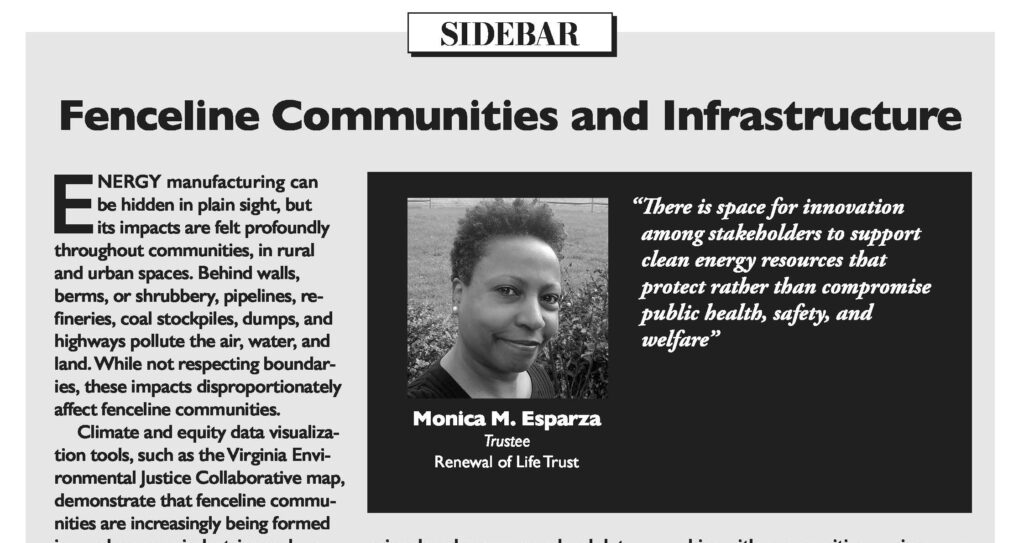This article was published in the Environmental Law Review September/October 2022
Energy manufacturing can be hidden in plain sight, but its impacts are felt profoundly throughout communities, in rural and urban spaces. Behind walls, berms, or shrubbery, pipelines, refineries, coal stockpiles, dumps, and highways that pollute the air, water, and land. While not respecting boundaries, these impacts disproportionately affect fence line communities.
Climate and equity data visualization tools, such as the Virginia Environmental Justice Collaborative Map, demonstrate that fence line communities are increasingly being formed in rural areas as industries seek new land and methods to modernize operations. Residents and industry alike seek service upgrades in broadband and power grid reliability, roads and clean transportation options, as well as shared revenues. The passage of the 2021 Infrastructure Investment and Jobs Act has boosted associated benefits to enhance economic stability in rural and urban areas. But with infrastructure expansion, fence line communities can be placed at risk.
In a globalized economy, companies are less physically bound to previous constraints of doing business. For example, a Virginia-based company can buy power from a wind energy development in Texas to offset emissions from electricity demand. This is known as a virtual power purchase agreement. As a result of this flexibility, infrastructure build-out, trade-offs, and accountability among community, government and business stakeholders have become more nuanced.
Still local and state conventions are often referenced first in land use administration and approval. In broad conversations of economics and social direction, discussions about development struggles, energy consumption, climate change hazards, and environmental justice start here. While civil rights legislation of prior decades ensures a legal duty for businesses to notify communities of operational intent, development decisions are primarily guided by elected, appointed and quasi government interests, often driven by policy, institutional sponsors, and incentives such as advancing clean energy without much regard for environmental impacts.
A national review of environmental justice initiatives and regulations reflected in the consultancy-produced Integral State Environmental Justice Compendium indicates that developers and regulators need more assistance for equity and acknowledging land rights and green infrastructure initiatives, particularly as business geographies continue to expand. Greater community participation in land use decision making is critical to accomplishing these important objectives.
Community organizing can and should be a complement to development projects, rather than adversity. A Virginia Environmental Justice Collaborative focus group composed of community leaders found that the availability of detailed knowledge, resources, and education can have substantially productive effects reconciling environmental conflicts. EPA similarly found that building stronger on-the-ground partnerships with communities can improve results. This requires transparency, education, and public participation that allows citizens to substantively influence processes rather than be made to take part in infomerical meetings. The new federal law will help to foster infrastructure resilience and development innovation. Human capital in support of equity should be earnestly and more robustly folded into negotiations with businesses in development phases to address environmental, health and climate change threats.
The current community engagement framework around infrastructure and its potential deleterious impacts on rural and urban areas is insufficient. Meaningful engagement is going beyond the preliminary step of acknowledging community rights. It is elevating mutual stakeholder interests in processes that have positive consequential impacts for decades, not transient media coverage and protest-hyped town hall meetings. It is valuing identities, the complexities of civic relationship, and authentically honoring stakeholder priorities.
There is space for innovation among stakeholders to support clean energy resource that protect rather than compromise public health, safety and welfare.

